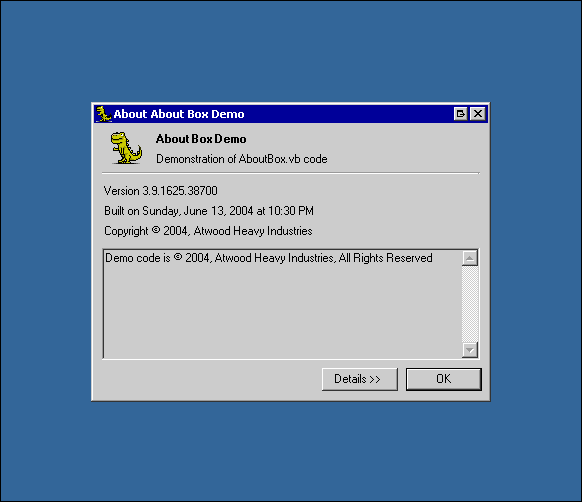
Introduction
The About Box dialog isn't an essential part of any application, but it serves an important role, as the "dogtags" for your application.
There are two distinct, and very different, audiences for this dialog.
- users: to identify the application's name, who made it, when it was created, and what version they have. Very basic stuff.
- developers: to provide extremely detailed build, version, and file information. Typically used when troubleshooting problems with compiled, deployed code.
You definitely should have an About Box-- but to continue with the dogtag analogy, if you're whipping out dogtags on a regular basis, that's symptomatic of a deeper problem (Mediiiic!). When you do need it, it can be a lifesaver. It's OK to be used infrequently, but it also needs to provide decent diagnostic info. Decorative About Boxes with their scrolling text and 3D graphics may be fun, but they aren't helpful.
In order to serve the needs of these two vastly different user groups, my About Box provides two views: a simple, basic view for users, and a vastly more detailed view (accessible through a "More >>" button) for developers.
Using the code
This form is intended to be a standalone, resuable component; simply drag and drop the AboutBox.vb file into your project, then instantiate it as you would any other form. It has no special dependencies.
Private Sub MenuItemAbout_Click(ByVal sender As System.Object,_
ByVal e As System.EventArgs) Handles MenuItemAbout.Click
Dim frmAbout As New AboutBox
frmAbout.ShowDialog(Me)
End Sub
That provides the simplest, default About Box behavior. This should work for most applications right out of the box (as pictured in the screenshot). If you want to customize the form's behavior, it does have a number of optional properties that can be set before showing the dialog:
Public Property AppEntryAssembly() As System.Reflection.Assembly
Public Property AppTitle() As String
Public Property AppDescription() As String
Public Property AppVersion() As String
Public Property AppCopyright() As String
Public Property AppImage() As Image
Public Property AppMoreInfo() As String
Public Property AppDetailsButton() As Boolean
The sample application demonstrates how to set these properties to customize the text in the dialog.
Points of Interest
The primary information presented by the About Box form is automatically derived from the AssemblyInfo.* file. The AssemblyInfo.* file should always be populated for all of your assemblies as a best programming practice, but you'll want to make doubly sure in this case.
<Assembly: AssemblyTitle("About Box Demo")>
<Assembly: AssemblyDescription("Demonstration of AboutBox.vb code")>
<Assembly: AssemblyCompany("Atwood Heavy Industries")>
<Assembly: AssemblyProduct("Demo code")>
<Assembly: AssemblyCopyright("© 2004, Atwood Heavy Industries")>
<Assembly: AssemblyTrademark("All Rights Reserved")>
The rest of the detailed information is gathered through .NET's built in, and very powerful, reflection capabilities.
The build date is automatically calculated for each assembly based on the Build and Revision numbers specified in the AssemblyInfo.*:
<Assembly: AssemblyVersion("4.1.*")>
This algorithm only works if standard auto-increment values were used (as pictured):
dt = CType("01/01/2000", DateTime). _
AddDays(AssemblyVersion.Build). _
AddSeconds(AssemblyVersion.Revision * 2)
If TimeZone.IsDaylightSavingTime(dt, _
TimeZone.CurrentTimeZone.GetDaylightChanges(dt.Year)) Then
dt = dt.AddHours(1)
End If
If dt > DateTime.Now Or AssemblyVersion.Build < 730 Or _
AssemblyVersion.Revision = 0 Then
dt = AssemblyLastWriteTime(a)
End If
If you've overridden the Build or Revision numbers, I can't calculate build date that way. In those scenarios, I use GetLastWriteTime on the assembly DLL file. I'm not aware of any more accurate methods to get build date, but between these two, the build time is usually correct.
History
- Monday, June 14, 2004 - Published.
- Sunday, December 19, 2004 - Version 1.1
- code refactored for readability and simplicity.
- switched to
RichTextBox for more text, so URLs and MAILTO are automatically supported in .AppMoreInfo property. - More assembly properties are enumerated in the Assembly Detail tab.
- converted to VB.NET 2005 style XML comments.
- now with 36% more cowbell!
- Wednesday, Janary 30, 2007 - Version 1.2
- Added support for using proper system font
- Tested in Windows Vista
- Ported to Visual Studio 2005 and .NET 2.0
- Monday, February 26, 2007 - Version 1.2a
- Added C# version, thanks to Scott Ferguson!
 General
General  News
News  Suggestion
Suggestion  Question
Question  Bug
Bug  Answer
Answer  Joke
Joke  Praise
Praise  Rant
Rant  Admin
Admin 










 May I recommend the RichTextBox for simple URL and mail encoding with no code? Not always the most elegant, but it's free!
May I recommend the RichTextBox for simple URL and mail encoding with no code? Not always the most elegant, but it's free!